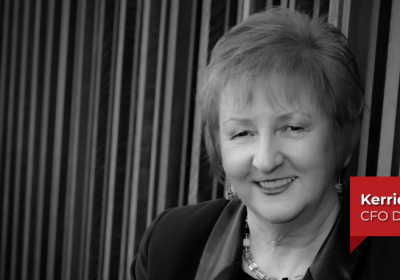
- Author: Jessica Mudditt
- Posted: May 24, 2023
The CFO ‘Charged’ with Driving Transformation > Club Assist CFO, Darshan Parikh
Darshan Parikh is CFO of Club Assist, which partners with automotive clubs across the Asia Pacific and North America to provide mobile battery replacements. In 2017, his team embarked on a three-year digital transformation that led to gaining a 360-degree view of the business – From ‘big bang’ to continuous improvement, CFO Magazine’s Jessica Mudditt discusses with Darshan what it takes to lead and drive change.
Thirty years ago, a stranded motorist with a flat battery had only two options: get a jump-start from someone passing by or be towed to the nearest mechanic. In a country of vast distances like Australia, this was hugely inconvenient.
In 1991, Club Assist offered Australian motorists the first ever roadside battery replacement service. It began as a single partnership with an automotive club and within few years it had formed multiple partnerships and expanded nationally.
When Parikh joined Club Assist as group corporate controller 15 years ago, the company was family-run, rather than being fully owned by Australian automotive clubs. Its global footprint has also grown over the years to include the New Zealand, United States and Canada.
“It has been a fascinating journey,” says Parikh. He stresses that the international expansion of the business was made possible by building a collaborative team around him.
The blank page moment
Parikh became CFO eight years ago and in 2018 he took on the company’s technology and data analytics portfolio. He began thinking about how technology was supporting the business, and whether there was an opportunity for it to add greater value.
At the time, Club Assist’s technology stack mostly consisted of purpose-made servers and legacy applications, and its Excel-led reporting involved many complicated macros. Parikh saw this as an enterprise risk: he knew that an error could lead to a catastrophic impact.
“I looked at our tech stack and thought about it from a blank page perspective,” he says. “If we were to start afresh and the business had no constraints in terms of capital and time, what would the ideal technology architecture look like? Would it add significant value to our employees and to our customers?”
Parikh identified a digital-first model that would be game-changing for Club Assist, but it would require a series of investments. Approaching these investments in a bite-sized way seemed the most practical way forward.
“We came up with a plan that proposed a big bite to start off the project, followed by small bites incrementally, year-on-year,” explains Parikh.
In 2018, Parikh and his team embarked on a full year of planning the adoption of Microsoft Dynamics 365.
“When it comes to a technology transformation, it’s so easy to underestimate the planning,” says Parikh. “We planned to a level of detail that gave us comfort as we embarked on the project. We were very clear about what we wanted to do. That planning phase was critical.”
Parikh and his team consulted with all levels of business and asked for their buy-in and ideas. Parikh also seconded a total of 10 people to work on the project full-time. Two people were seconded from each function on a full-time basis, including members of finance in accounting, commercial finance, supply chain and warehousing operations. Their roles were back-filled within the business, and they worked alongside a team of external consultants.
“It was a complex project that required a lot of different skillsets,” says Parikh.
“We invested in a professional team to help us execute the project because we acknowledged that we couldn’t do it with our existing resources. Having a dedicated team of ‘super users’ made a massive difference. It was their day-in, day-out job to get us to the endpoint.”
Whole of business view
Microsoft Dynamics 365 was chosen as the new system because it could provide a connected ecosystem with a real-time view of the business.
“It could give us that whole-of-business view – whether it was the warehousing technology, field service technology at roadside, or the office technology in terms of everything we use within our finance and admin functions,” says Parikh.
Another aspect of the digital transformation involved moving its data from servers to the cloud, which proved to be invaluable during the Covid-19 lockdowns when its workforce suddenly went remote.
The project went live at the end of 2020 with a ‘big bang’ that saw the foundational layer upgraded and delivered. Every quarter, Parikh and his team add new features that continuously improve the user experience.
“This has created agility within the business. The digital transformation never really stops. We are now upskilling staff to take ownership of their functions and to ask their ideas about whether the process could be done better.”
The biggest benefit of the long-term undertaking is having a technology stack that Parikh describes as modern and secure. The ability to access it from anywhere and at any time has delivered a competitive edge for staff and customers.
“We’ve now got a technology offering which adds value to customers. It allows them to interact digitally with us,” says Parikh.
This in turn led to opportunities to grow the company’s digital sales channel. It the past, its customers could not buy Club Assist products online. Having a 360-degree view of the customer journey has also illuminated consumer preferences and pain-points. By being more responsive, Club Assist can further grow its market share.
A sector on the cusp of change
Over time, Club Assist has doubled down on its core offering of providing a mobile battery program, rather than spreading itself too thin over different business segments. As battery technology experts, Club Assist specialises in the sourcing, storage, distribution and installation of automotive, recreational and commercial batteries. Its market share is in lead acid batteries and it is one of the largest battery sellers by volume in Australia, as well as being one of the largest players in the roadside battery market. It has a small penetration in the retail and D-I-Y segments.
However, the lead acid batteries that have dominated the market for decades may one day be superseded by new technologies. For example, the AGM (absorbed glass mat), lithium and solid state batteries are more powerful and could play a leading role in fulfilling future energy needs.
“We’ve got electric vehicles coming through which will require a different type of battery technology,” he says. “We’ve also got autonomous vehicles also coming through further in the future. It will be fascinating to see how technology reshapes the industry.”
He foresees a time when consumers have more control over their energy output: there may be a battery for the car and a home battery, with energy transference between the two a simple and straightforward process.
“A company like Club Assist has the technology and expertise in understanding batteries,” says Parikh. “We’re looking at how we can be involved with these emerging opportunities. Club Assist is well positioned in the sector to play quite a dominant role.”








